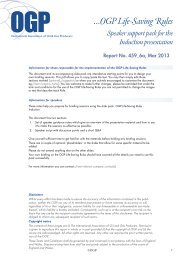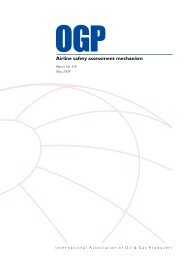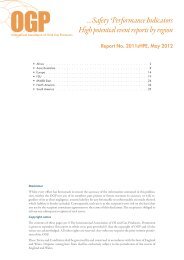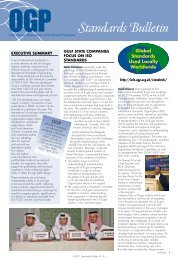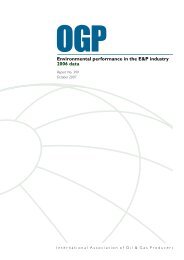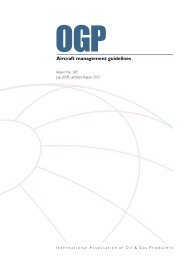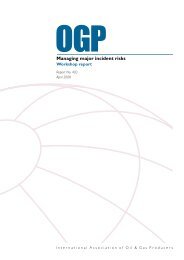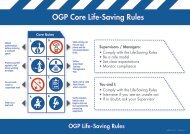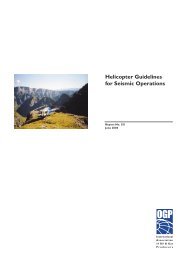Helicopter guidelines for land seismic & helirig operations - OGP
Helicopter guidelines for land seismic & helirig operations - OGP
Helicopter guidelines for land seismic & helirig operations - OGP
You also want an ePaper? Increase the reach of your titles
YUMPU automatically turns print PDFs into web optimized ePapers that Google loves.
<strong>Helicopter</strong> <strong>guidelines</strong> <strong>for</strong> <strong>land</strong> <strong>seismic</strong> & <strong>helirig</strong> <strong>operations</strong><br />
Annex G<br />
Generic hazards & controls inventory<br />
The appendices present an inventory of known hazards in <strong>land</strong> helicopter supported geophysical<br />
<strong>operations</strong>. They also incorporate suggested controls that may be used to reduce the potential<br />
risks presented by these hazards. The inventory captures industry experience on causes of<br />
accidents in the past and should be consulted when compiling the <strong>for</strong>mal Hazard Register <strong>for</strong><br />
the HSE-MS of an operation with helicopters.<br />
The words ‘hazard’ and ‘risk’ are used loosely in association with the widest possible meaning of<br />
ëanything with a potential to cause harmí.<br />
Risks (be<strong>for</strong>e and after controls are applied) must be assessed on a case-by-case basis, as they will<br />
depend on the type and location of an operation.<br />
Common ground is generally not addressed. The focus is on specific <strong>land</strong> helicopter supportrelated<br />
hazards. However, to err on the safe side, some hazards common to other types of<br />
<strong>operations</strong> are included.<br />
Also, most general aviation hazards, such as mechanical failures of the aircraft or pilot error etc.<br />
are not included.<br />
G.1 Environmental hazards & suggested controls<br />
Weather<br />
Hazard description<br />
Adverse weather conditions that may affect<br />
helicopter <strong>operations</strong> include:<br />
• Low clouds, fog, rain or snow reducing visibility,<br />
risk of:<br />
—Collision — with obstacles.<br />
—Getting — lost during VFR flights.<br />
• Freezing temperatures that may result in:<br />
—slippery — walkways,<br />
—ice — accumulation on the aircraft.<br />
—ice — accumulation can also be the cause of<br />
breaking antenna wires etc.<br />
—adversely — affect engine per<strong>for</strong>mance (failure to<br />
start).<br />
• Strong winds, especially around hilltop helipads<br />
can:<br />
—Affect — the flight path of the helicopter.<br />
—Cause — trees at edges of <strong>for</strong>est (helipads, rivers<br />
etc) to fall.<br />
—Cause — dust or light objects in the air (FOD)<br />
• Glare from low or reflected sun:<br />
—Can — be blinding to pilot<br />
—May — make a helipad difficult to locate<br />
Suggested controls<br />
• Plan <strong>operations</strong> taking into account prevailing<br />
weather conditions and the extremes that can be<br />
expected in the course of the <strong>operations</strong>.<br />
• Ensure availability of regular, reliable weather<br />
<strong>for</strong>ecasts and advanced warning system <strong>for</strong><br />
adverse conditions.<br />
• Avoid weather conditions that are outside<br />
the operating envelope of the aircraft in use.<br />
Availability and map of emergency <strong>land</strong>ing<br />
locations.<br />
• Incorporate weather conditions in Manual Of<br />
Permitted Operations and Emergency Response<br />
Plan.<br />
• The Pilot has the obligation and must have the<br />
authority to suspend or modify <strong>operations</strong>, without<br />
further approval from management, in case of<br />
adverse weather.<br />
• Avoid presence of personnel at edge of helipads<br />
cut in jungle, as trees may fall inwards. Place<br />
camps, shelters etc well inside the <strong>for</strong>est.<br />
• Keep <strong>land</strong>ing pad at least one tree height away<br />
from tree line.<br />
• Minimize flying below tree line.<br />
• Avoid dry dusty helipads, spray with water or<br />
treat/cover otherwise.<br />
• Housekeeping: no loose light materials near<br />
helipad or flight path.<br />
• Take into account when positioning helipads and<br />
related direction of approach path.<br />
• Avoid strongly reflecting surfaces near <strong>land</strong>ing<br />
locations<br />
© <strong>OGP</strong><br />
65



